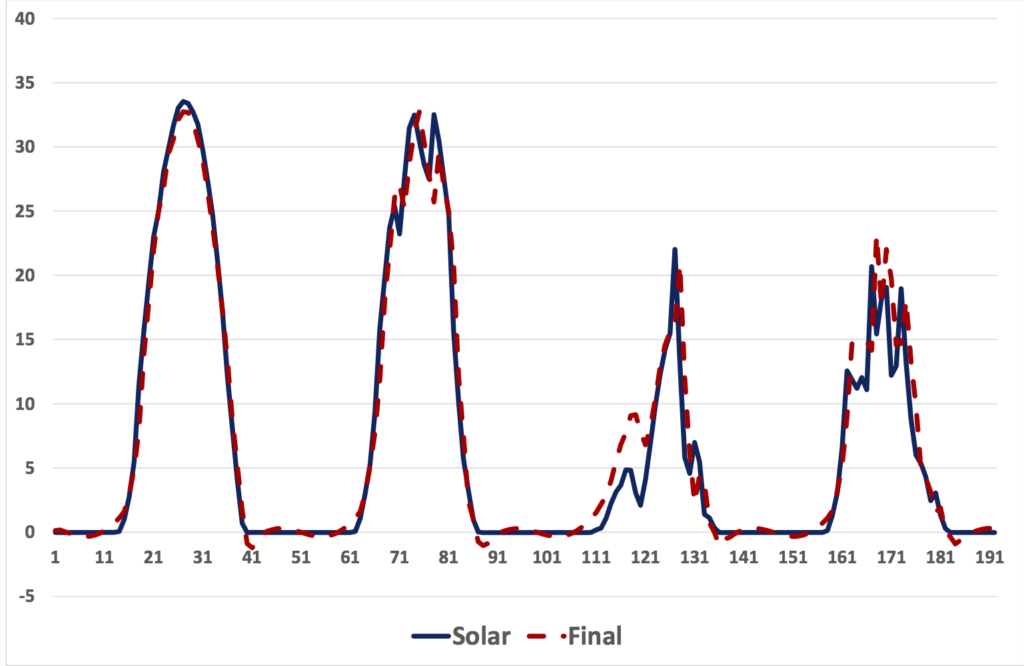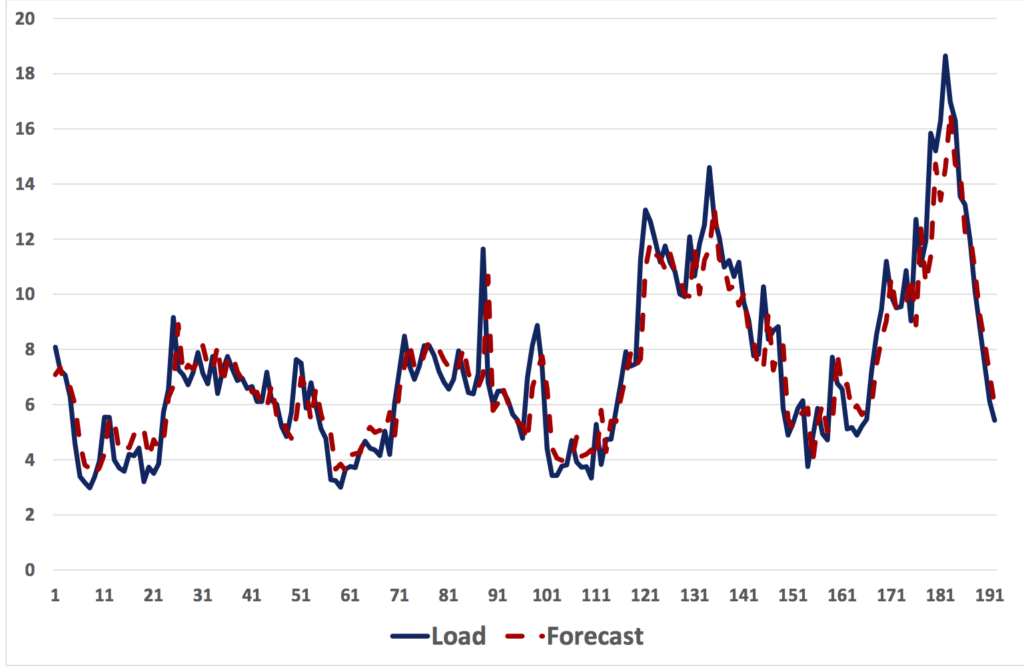Electricity pricing and control mechanisms for microgrids
Industry representative: Travis Kauschke, SA Power Networks
Moderators: John Boland, University of South Australia; Ayham Zaitouny, CSIRO, Mineral Resources, Western Australia
Introduction
SA Power Networks (SAPN) are the sole electricity distributor in South Australia, and are responsible for operating, maintaining and upgrading the network used to distribute electricity to end users. Like similar businesses throughout the world, they face some key challenges:
- controlling peaks in power flows in the network, since these increase the required network capacity and hence the cost of the distribution network
- enabling increased use of distributed renewable energy generation and energy storage, such as rooftop photovoltaic systems and batteries.
Future communities are likely to feature embedded electricity microgrids with low-capacity connections to the wider supply network. Within a community, customers will use rooftop photovoltaic systems to generate energy, and energy storage systems and demand management to control their energy use. Control of electricity use within a community is required to manage peak power flows and to maximise the use of local energy from renewables. This control can be achieved using a combination of centralised control of generation, energy storage, and loads, and decentralised control based on real-time price signals.
SA Power Networks was interested in investigating electricity pricing and control mechanisms that will:
- minimise the cost of electricity for a community
- share the costs fairly between customers within the community
- empower customers to further reduce their bills by changing their behaviour
- reward customers who behave in ways that benefit the community
- ensure reliability and quality of electricity supply.
Delegates at MISG divided into groups to investigate different aspects of the problem:
- a review of the literature on microgrids
- analysis of cost savings achievable by the community using bulk supply tariffs
- optimal control of energy storage to minimise the cost of energy imported into the community
- use of cooperative game theory to determine how to split the community energy bill amongst individual households
- simulation and forecasting methods to support further analysis.
Our findings are discussed in the following sections.
Cost savings from bulk-supply tariffs
Individual residential customers in South Australia typically pay a supply charge of $0.78 per day and an energy charge of $0.35 per kilowatt-hour for electricity use (less with prompt-payment discounts), and are paid $0.068 for energy exported to the grid. A community operating their own microgrid, with a single connection point to the wider distribution network, would pay a ‘bulk supply’ tariff with three components:
- a fixed supply charge of $5 per day
- energy charges:
- $0.20/kWh for energy imported during peak times (07:00 – 21:00 each day)
- $0.10/kWh for energy imported during off-peak times
- $0.05/kWh for energy exported
- monthly demand charge:
- $16/kVA each month for the maximum demand within demand peak times (16:00 – 21:00, November – March)
- $8/kVA each month for the maximum demand with shoulder times (12:00 –16:00 all year).
SAPN provided half-hourly energy data from 105 households with PV generation and batteries. This data included measurements of PV generation, household load, battery charge, and battery discharge. Some data was missing, but we were able to build a complete data set for 20 houses over an 18-day period spanning October and November 2016. This data was aggregated to produce an example of community generation and load over the 18-day period. We also constructed some simple models that we could use to simulate daily community power usage and PV solar generation. These models were based on the data supplied by SAPN, and were used for our further investigations.
With seven or more households in a community, the daily supply charge of the community bulk supply tariff is less than the sum of the supply charges for individual residential energy tariffs. Energy charges are more difficult to compare, because the bulk supply tariff considers when energy is used whereas the residential energy tariff does not. To do a meaningful comparison of community costs with the two tariffs you need at least a year of data, to cover seasonal variations. In the weeks following MISG, we applied the two tariffs to a year of data from 29 households at Lochiel Park. These households have PV generation but no storage. The sum of individual energy bills was $41700. With the bulk supply tariff, the community bill was $23100—a saving of 44%. However, this saving would have to pay for the operating and maintenance costs of the microgrid, including the costs associated with individual billing.
Optimal control of storage
During MISG we calculated the impact of PV generation on the community electricity bill for the 20 households over 18 days in November, and then calculated the further savings that could be achieved with storage. Rather than use the measured battery charge and discharged profile of individual households, we assumed that the storage would be controlled centrally to maximise the benefit to the community. The combined energy storage of the 20 households had an energy capacity of 128 kWh and a charge and discharge rate of 66 kW. We assumed a turn-around efficiency of 90%. We used optimal control theory to confirm that the store should be charged when the import price was low and discharged when the import price was high.
The table below shows energy costs for nine scenarios, based on the 18 days of data from 20 households. The different columns represent different load cases, and the rows represent different combinations of solar and storage.
| baseline load | balanced | high load | |
|---|---|---|---|
| no solar, no store | $1,006 | $1,286 | $1,509 |
| solar, no store | $193 | $377 | $529 |
| solar, store | -$45 | $60 | $182 |
The baseline load is 6113 kWh; the solar generation in all load cases is 7819 kWh of solar PV harvested over the 18 days of data. In the second column, the load is increased to 7819 kW to match the solar generation. In the last column, the load is increased to 1.5 times the baseline load.
In all cases there is enough storage that energy is drawn from the grid only during off-peak energy times, and so there are no peak demand costs.
This analysis is based on the 18-day SAPN data set. It should eventually be redone using data for a complete year.
Another group used a Mixed Integer Programming model to determine the optimal operation of storage, comparing control by individual households to central, coordinated control of the storage. The results are show in this table:
| individual | coordinated | |
|---|---|---|
| energy imported from the grid, kWh | 1,872 | 1,363 |
| energy exported to the grid, kWh | 3,010 | 2,541 |
| energy generated by rooftop PV, kWh | 7,319 | 7,319 |
| energy stored in battery, kWh | 1,773 | 1,949 |
| energy discharged from battery, kWh | 1,486 | 1,703 |
| energy consumed, kWh | 5,894 | 5,894 |
Coordinated control requires less energy from the grid and exports less energy to the grid, so will have a lower overall cost. However, it also uses more storage.
Fair distribution of the community bill
We were able to show that the community bill using a bulk supply tariff will be significantly less than the sum of individual energy bills for communities of more than about seven households, and that central control of storage gives lower community bills than individual control. However, we still need a mechanism to determine each household’s fair share of the community bill.
A key idea from cooperative game theory is that each household’s share of the community bill should be less than if they paid an individual energy bill. One way to achieve this is to calculate the sum of individual energy bills, calculate each household’s proportion of this sum, then apply these proportions to the community bulk supply bill. This guarantees that each household has a bill lower than if they had paid as an individual, since the bulk supply bill will be less than the sum of the individual energy bills. But is arguably not fair, since it does not take into account how much each household contributed to time-of-use energy charges in the bulk supply tariff. For example, if there are two households with the same energy use but one household has all of their energy use in the peak demand period when energy costs are high, then that household should pay more.
Another way to distribute costs is to calculate how much each household contributes to the supply charge, energy charges and demand charges of the community bill. In this case, however, a household with low energy use but high peak demand could have a lower individual energy bill than their share of the community bill, which would entice them to leave the community scheme. This scenario will become less likely as energy consumption tariffs are inevitably replaced by time-of-use tariffs.
Since MISG we have evaluated these two schemes using data from 29 households at Lochiel Park. For this data set, without storage, every household is better off paying for their contribution to the bulk supply bill than with an individual energy tariff, and so no customers would leave the community scheme. With the first cost distribution scheme, based on the energy tariff, each household had a cost saving of 45%. With the second distribution scheme, savings ranged from 30% to 60%, with a median of 44%.
Supply and load forecasting
The optimisation studies performed during MISG assumed perfect knowledge of the load and solar supply for all time periods. Obviously this is unrealistic in practice, where future solar supply and load is not known. You could make decisions about how to control the energy store with no knowledge of future supply and load, or instead use forecast values.We performed an experiment, based on previous work, to illustrate the construction of one-step-ahead forecast models for solar and load and solar. These models encompassed a seasonal component described using Fourier series plus an autoregressive component. The figures below compare predicted solar and load to actual solar and load.


Conclusions
We have demonstrated that community energy bills can be reduced significantly by using a bulk demand tariffs, for communities with more than about seven households. Solar generation and electrical energy storage also lower the cost of energy imported from the grid.For a community with distributed storage, centralised coordinated control of the storage systems will give greater cost savings for the community than if households control their storage systems independently.
A key problem is how to apportion the community energy bill amongst the individual households. We used principles from cooperative game theory to demonstrate two possible schemes.
Contributors
The team that contributed to this work included: Silvio Tarca, Manju Agrawal, Adrian Grantham, Lui Cirocco, Mina Rouhollahi, Charles Ling, Angus Lewis, Hilary Hunt, Alex Zarebski, Sleiman Farah, Jaewon Jung, Ben Luo, Peter Pudney, Travis Kauschke (SAPN), Ayham Zaitouny and John Boland.
